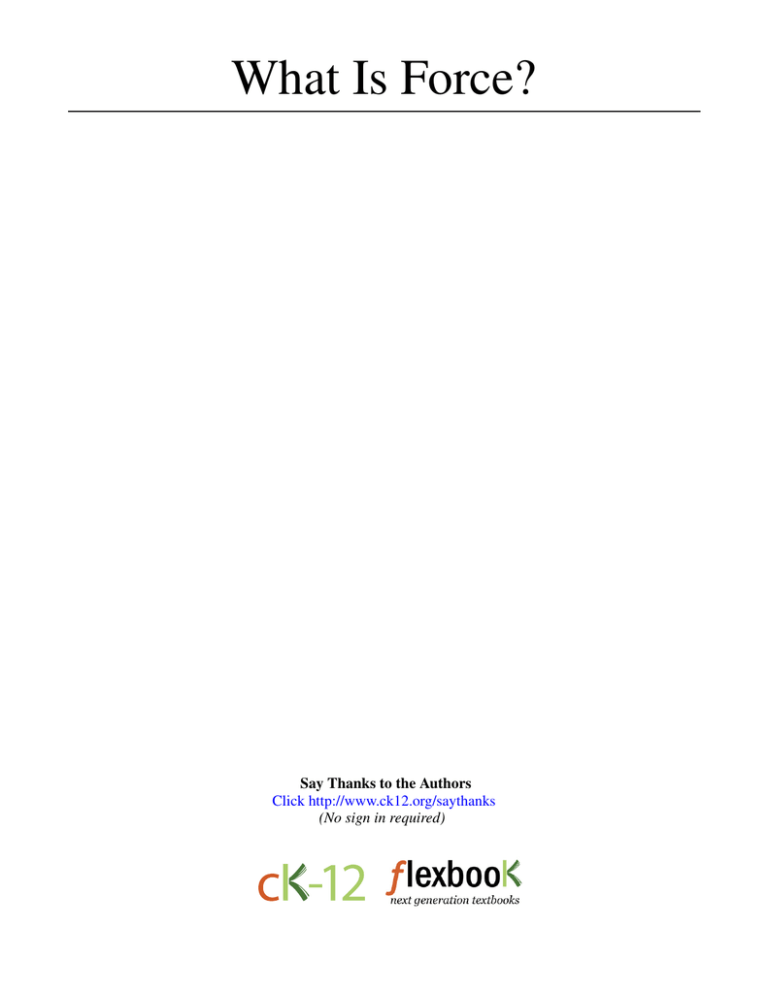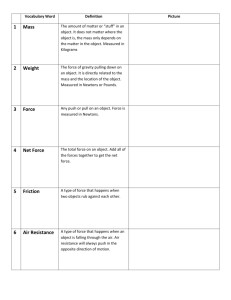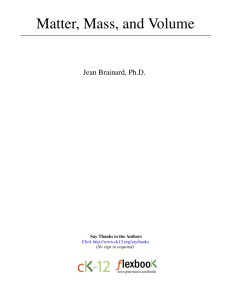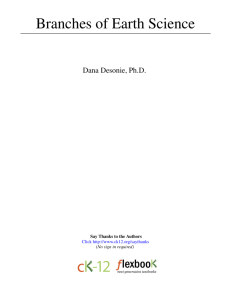What Is Force? Say Thanks to the Authors (No sign in required) Click
advertisement

What Is Force? Say Thanks to the Authors Click http://www.ck12.org/saythanks (No sign in required) To access a customizable version of this book, as well as other interactive content, visit www.ck12.org CK-12 Foundation is a non-profit organization with a mission to reduce the cost of textbook materials for the K-12 market both in the U.S. and worldwide. Using an open-content, web-based collaborative model termed the FlexBook®, CK-12 intends to pioneer the generation and distribution of high-quality educational content that will serve both as core text as well as provide an adaptive environment for learning, powered through the FlexBook Platform®. Copyright © 2012 CK-12 Foundation, www.ck12.org The names “CK-12” and “CK12” and associated logos and the terms “FlexBook®” and “FlexBook Platform®” (collectively “CK-12 Marks”) are trademarks and service marks of CK-12 Foundation and are protected by federal, state, and international laws. Any form of reproduction of this book in any format or medium, in whole or in sections must include the referral attribution link http://www.ck12.org/saythanks (placed in a visible location) in addition to the following terms. Except as otherwise noted, all CK-12 Content (including CK-12 Curriculum Material) is made available to Users in accordance with the Creative Commons Attribution/NonCommercial/Share Alike 3.0 Unported (CC BY-NC-SA) License (http://creativecommons.org/licenses/by-nc-sa/3.0/), as amended and updated by Creative Commons from time to time (the “CC License”), which is incorporated herein by this reference. Complete terms can be found at http://www.ck12.org/terms. Printed: August 19, 2012 www.ck12.org C ONCEPT Concept 1. What Is Force? 1 What Is Force? Lesson Objectives • Define force, and give examples of forces. • Describe how forces combine and affect motion. Lesson Vocabulary • force • net force • newton (N) Introduction Any time the motion of an object changes, a force has been applied. Force can cause a stationary object to start moving or a moving object to accelerate. The moving object may change its speed, its direction, or both. How much an object’s motion changes when a force is applied depends on the strength of the force and the object’s mass. You can explore the how force, mass, and acceleration are related by doing the activity at the URL http://www.harco urtschool.com/activity/newton/. This will provide you with a good hands-on introduction to the concept of force in physics. Defining Force Force is defined as a push or a pull acting on an object. Examples of forces include friction and gravity. Both are covered in detail later in this chapter. Another example of force is applied force. It occurs when a person or thing applies force to an object, like the boy pushing the swing in Figure 1.1. The force of the push causes the swing to move. Force as a Vector Force is a vector because it has both size and direction. For example, the boy in Figure 1.1 is pushing the swing away from himself. That’s the direction of the force. He can give the swing a strong push or a weak push. That’s the size, or strength, of the force. Like other vectors, forces can be represented with arrows. Figure 1.2 shows some examples. The length of each arrow represents the strength of the force, and the way the arrow points represents the direction of the force. How could you use an arrow to represent the boy’s push on the swing in Figure 1.1? 1 www.ck12.org FIGURE 1.1 When this boy pushes the swing away from him, it causes the swing to move in that direction. FIGURE 1.2 Forces can vary in both strength and direction. SI Unit of Force The SI unit of force is the newton (N). One newton is the amount of force that causes a mass of 1 kilogram to accelerate at 1 m/s2 . Thus, the newton can also be expressed as kg·m/s2 . The newton was named for the scientist Sir Isaac Newton, who is famous for his law of gravity. You’ll learn more about Sir Isaac Newton later in the chapter. Combining Forces More than one force may act on an object at the same time. In fact, just about all objects on Earth have at least two forces acting on them at all times. One force is gravity, which pulls objects down toward the center of Earth. The other force is an upward force that may be provided by the ground or other surface. Consider the example in Figure 1.3. A book is resting on a table. Gravity pulls the book downward with a force of 20 newtons. At the same time, the table pushes the book upward with a force of 20 newtons. The combined forces acting on the book — or any other object — are called the net force. This is the overall force acting on an object that takes into account all of the individual forces acting on the object. You can learn more about the concept of net force at this URL: http://www.mansfieldct.org/schools/mms/staff/hand/lawsunbalancedforce.htm. 2 www.ck12.org Concept 1. What Is Force? FIGURE 1.3 A book resting on a table is acted on by two opposing forces. Forces Acting in Opposite Directions When two forces act on an object in opposite directions, like the book on the table, the net force is equal to the difference between the two forces. In other words, one force is subtracted from the other to calculate the net force. If the opposing forces are equal in strength, the net force is zero. That’s what happens with the book on the table. The upward force minus the downward force equals zero (20 N up - 20 N down = 0 N). Because the forces on the book are balanced, the book remains on the table and doesn’t move. In addition to these downward and upward forces, which generally cancel each other out, forces may push or pull an object in other directions. Look at the dogs playing tug-of-war in Figure 1.4. One dog is pulling on the rope with a force of 10 newtons to the left. The other dog is pulling on the rope with a force of 12 newtons to the right. These opposing forces are not equal in strength, so they are unbalanced. When opposing forces are unbalanced, the net force is greater than zero. The net force on the rope is 2 newtons to the right, so the rope will move to the right. FIGURE 1.4 When unbalanced forces are applied to an object in opposite directions, the smaller force is subtracted from the larger force to yield the net force. 3 www.ck12.org Forces Acting in the Same Direction Two forces may act on an object in the same direction. You can see an example of this in Figure 1.5. The man to the left of the piano is pushing the piano to the right with a force of 25 newtons. At the same time, the man to the right is pulling the piano to the right with a force of 20 newtons. When two forces act in the same direction, the net force is equal to the sum of the forces. This always results in a stronger force than either of the individual forces alone. In this case, the net force on the piano is 45 newtons to the right, so the piano will move to the right. FIGURE 1.5 When two forces are applied to an object in the same direction, the two forces are added to yield the net force. You Try It! Problem: The boys in the drawing above are about to kick the soccer ball in opposite directions. What will be the net force on the ball? In which direction will the ball move? If you need more practice calculating net force, go to this URL: http://www.physicsclassroom.com/class/newtlaws/U 2L2d.cfm. 4 www.ck12.org Concept 1. What Is Force? Lesson Summary • Force is a push or a pull acting on an object. Examples of force include friction and gravity. Force is a vector because it has both size and direction. The SI unit of force is the newton (N). • The combined forces acting on an object are called the net force. When forces act in opposite directions, they are subtracted to yield the net force. When they act in the same direction, they are added to yield the net force. Lesson Review Questions Recall 1. 2. 3. 4. Define force. Give an example of a force. What is a newton? What is net force? Describe an example of balanced forces and an example of unbalanced forces. Apply Concepts 5. What is the net force acting on the block in each diagram below? a. b. Think Critically 6. Explain how forces are related to motion. Points to Consider In the next lesson, "Friction," you will read about the force of friction. You experience this force every time you walk. It prevents your feet from slipping out from under you. • How would you define friction? • What do you think causes this force? 5







